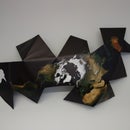Introduction: PACMAN Augmented Reality Ski Trainer Concept
The concept here is the following: you project a PACMAN path and pellets ahead of you to motivate yourself to push harder. The full application of this would be similar to the popular phone application "Zombies, Run!" where the environment (in the case of ZR the sound of zombies chasing you) changes depending on your speed and the stage of level you are playing. For the PACMAN trainer you could have the pellets whizzing by at different rates, and after swallowing a Power Pellet you would be encouraged to sprint to catch as many ghosts as possible. Again, this has not been implemented: it is merely a movie scrolling in front of you.
I am not sure that anyone will want to actually build this for themselves (I am unlikely to strap it on again), but as with all instructables, you can learn something about the concept and building process.
Step 1: ITEMS
If you wish to take on this project you will need:
- Pocket or Pico Projector (200-500$)
- Power source: in this case I used a 12V sealed lead acid (SLA) battery from an electric scooter (30$).
- Power converter: in this case I need to provide 110V AC to my projector (50$)
- Helmet to mount camera onto (40$)
- Mounting system: I used some Nd magnets from hard drives and a bent flat bar.
- Computer with PowerPoint or other software to make basic animations.
Step 2: Mounting the Projector
There are many ways you can accomplish this. There are likely some off the shelf mounts you can purchase (mounting cameras for extreme sports). I threw this together using some previously constructed items see this and this for the details on extraction of magnets and mounting a screw to hold the projector.
I then attached a Nd magnet to a bike helmet using stainless steel tie wraps. I bent a piece of flat steel in a vice to turn the projector onto its side to take advantage of the aspect ratio to project further out. The L-shaped bar sticks to the magnet on the helmet and the projector sticks to the same bar with its own magnet.
The battery was connected to the power converter with alligator clips and the projector is plugged into the converter. I had initially wanted to stream video from my smartphone, but ran into many issues. I ended up creating MP4 movie files, loading them on a microSD card and using the integrated player in the projector itself.
Step 3: Creating the Video
- Draw the two blue lines representing the edge of the corridor. They widen at the edge nearest the skier because of the projector aspect ratio (extreme keystone effect because you are projecting at an oblique angle)
- Draw the pellets: I used two overlapping white rectangles. Group it for ease of manipulation.
- Copy and paste the pellets until you have 8 of them.
- Spread them apart a constant distance, this will ensure that when the animation loops, you don't get too much of a jump.
- Group the 8 pellets.
- Add custom animation (line). In the new versions of Powerpoint you can see a ghost of the starting position, try to match the ghost with the original position of other pellets (again to avoid the jump when the animation is looped). The direction should be towards the wide end of the blue lines (towards the skier).
- Change the settings of the animation: remove "smooth start" and "smooth end", set speed to "very slow" and set "Repeat till end of slide".
- In the "Transitions" ribbon menu: Change the settings of the "Advance Slide" to "After" and set 30 seconds.
- Use "Export" and "Create Video" to export the video in the format of your choice.
Step 4: Get Out There
- Ambient light (not as much an issue in winter in northern or southern extremes due shorter days)
- Projection surface (snow is excellent surface compared to most natural surfaces),
- Smoothness of the mount (jogging is super bouncy and could cause motion sickness).
I am sure that we are going to see some commercial attempts at this type of sport training video games, but more likely with the use of head's up displays such as google glass, which is less cumbersome and offers some real augmented reality action.

Participated in the
Full Spectrum Laser Contest

Participated in the
Game.Life 4 Contest













